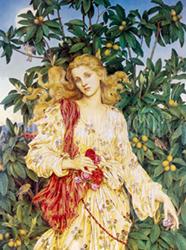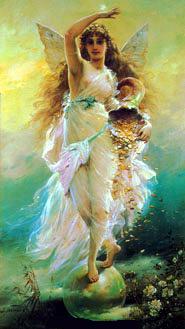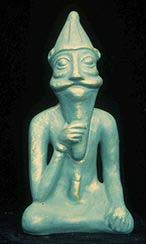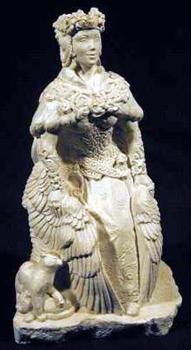




The personification of luck, hopefully of good luck, but she could be represented veiled and blind, as modern depictions of Justice are seen, and came to represent the capriciousness of life.
Fortuna had a retinue that included Copia among her blessings. Under the name Annonaria she protected grain supplies. In the Roman calendar, June 11 was sacred to Fortuna, with a greater festival to Fors Fortuna on the 24th.
Fortuna was propitiated by mothers. Traditionally her cult was introduced to Rome by Servius Tullius. Fortuna had a temple in the Forum Boarium, a public sanctuary on the Quirinalis, as the tutelary genius of Roma herself, Fortuna Populi Romani, the "Fortune of the Roman people", and an oracle in Praeneste where the future was chosen by a small boy choosing oak rods with possible futures written on them.
All over the Roman world, Fortuna was worshipped at a great number of shrines under various titles that were applied to her according to the various circumstances of life in which her influence was hoped to have a positive effect. Fortuna was not always positive: she was doubtful (Fortuna Dubia); she could be "fickle fortune" (Fortuna Brevis), or downright evil luck (Fortuna Mala).
Her name seems to derive from the Italic goddess Vortumna, "she who revolves the year".
Frey

Frey was the Nordic God of Rain and Sun. In Sweden the life-size wood image of this Lord of Animal and Vegetative Fertility was carried in Spring by wagon, accompanied by a maiden chosen to represent his consort-sister Freya. Frey is consonant with the dying-resurrecting Roman deity Priapus, his annual sacred joining with Freya bringing rebirth to the land. The Norse and Germanic feast of Yule celebrated Frey's re-emergence; Yule log and tree are the god's personae hidden within our festival of Christmas. Frey wielded a phallic sword, and in this depiction rides the indomitable boar, Celtic symbol of prosperity, virility and ceremonial feasting.
Freya

Freya was Goddess of Love and Fertility. She ruled Odin's Valkyries and is reputed to have taught him women's mysteries. Together with her consort-brother Frey she was ruler of the Vanir, ancient matrifocal nature deities who pre-existed Norse patriarchy. Her name translates from the Old Norse simply as "Lady". This meant more in that language than it does now in ours. The word was the feminine counterpart to 'Lord' in its fullest sense of power and authority, implying divinity. In the diverse Norse pantheon, she stood forth as an unusually diverse and strong figure. Here she is shown smiling, encircled by her great necklace Brisingamen. Goddess of the moon, of love, and of childbirth, she gave her name to Friday. As the Norse goddess of wealth, fertility, warfare, and love, the blue-eyed Freya was famed among men, gods and giants for her beauty. She also was a knowledgeable magician, and it was she who taught Odin the shamanic magical practices known as seidr. The Norse continued these practices into Christian times.
More Coming......
